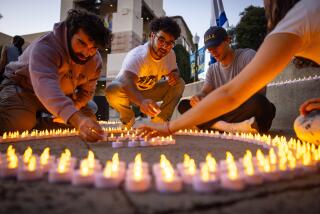The Birth of Israel Has Produced a Troubled Life
- Share via
No sooner had Israel declared its independence on May 14, 1948, than it found itself engaged in a multi-front war to preserve not only its nascent statehood but also its very existence.
The previous November the U.N. General Assembly had accepted the recommendations of a special commission to partition Palestine into two states, one Arab and one Jewish, with Jerusalem as a separate entity under international trusteeship. The plan was a variation of a decade-old proposal by another commission that had struggled with what a British statesman of the time called “a conflict of irreconcilable national aspirations.” The Arab leadership rejected partition in 1937 and 1947, and the U.N. vote led to an eruption of violence across Palestine.
Arabs and Jews had lived in relative amity for the previous four centuries under the rule of the Ottoman Turks. But the country’s defeat in World War I cost Turkey its empire. The new League of Nations made Palestine a British “mandate,” envisioning its eventual independence. At the time, Arabs in Palestine outnumbered Jews about 9 to 1.
As Jewish immigration crept upward, however, Arab concerns grew and communal violence increased. Nazism’s rise in Germany and Austria in the 1930s prompted growing numbers of European Jews to look to Palestine as a possible sanctuary, but strict quotas limited entry. In a few years the Holocaust would snuff out the lives of 6 million of Europe’s Jews and give enormous impetus to the Zionist dream of a Jewish national home in Palestine.
But what many saw as the inescapable postwar need for an independent and secure refuge for Jews was viewed by Arabs as a Western imperialist intrusion into a land that had been Muslim for close to 13 centuries. The notion of a federal state that would assure equal rights to Arabs and Jews vanished as two peoples, each convinced of the moral justice and historical validity of its claims, girded for battle. Britain found that it could not keep the peace, even with 100,000 troops, and in 1947 it handed the Palestine problem to the United Nations.
Terrorism had always been an element in the struggle for Palestine, and as Israel moved toward independence, terrorist episodes multiplied. The worst atrocity occurred the night of April 9-10, 1948, when the extremist underground Jewish group Irgun fell upon the Arab village of Deir Yassin near Jerusalem, massacring 245 women, children and men. Not long after, Arab irregulars attacked a Jewish medical convoy, killing 77 doctors and nurses. For decades to come, civilian lives on both sides of the conflict would remain at risk.
*
The U.N. partition plan envisaged a Jewish state that in early 1948 would contain 407,000 Arabs alongside 498,000 Jews, and an Arab state that would include 10,000 Jews among 725,000 Arabs. Israel’s 1948 war of independence markedly altered the plan’s boundaries and demographics. Even before Israel declared independence, some Arabs began to leave their homes. Many more fled during the general fighting that began May 14. In all, more than 600,000 Palestinian Arabs became refugees. The population transfer was not one-sided. In the next few years, almost 500,000 Jews were expelled from or chose to leave their ancestral homes in Yemen, Iraq, Syria, Egypt and North Africa.
The fight for Palestine quickly became international as Iraq, Syria, Lebanon, Jordan and Egypt threw their armies against the Jewish state. The consensus in Western capitals, including Washington, was that Israel would soon be crushed. The experts were to be surprised, along with the Arabs. Overcoming staggering deficits in manpower and weaponry, Israel fought its way to victory, helped by the failure of the Arab states to coordinate their military operations or agree on strategic goals. The one thing the invading states did agree on was their lack of support for an independent Palestine. Instead, each pursued its own national aims. The most successful was Jordan, which overran and annexed the West Bank of the Jordan River and East Jerusalem.
The end of the fighting found Israel a larger and more integral state than the partition plan had offered. The armistices that followed, however, did not halt its conflicts with the Arabs. Those would go on into the 1990s and claim tens of thousands of lives. In less than half a century, the fragile state that was born at 5 o’clock in the afternoon of May 14, 1948, in the main hall of the Tel Aviv Museum was to become the Middle East’s most advanced and powerful nation. However, the hope for peace and neighborly acceptance that the founders expressed in their declaration of independence still awaits full realization.
More to Read
Sign up for Essential California
The most important California stories and recommendations in your inbox every morning.
You may occasionally receive promotional content from the Los Angeles Times.













